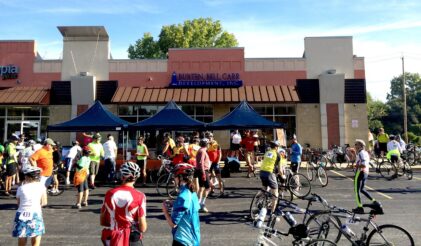Community Development Corporations (CDCs) Community Development Corporations (CDC) are neighborhood-level, placed nonprofits dedicated to improving their geographic area of operation. Improvements are focused on physical, social, and economic wellbeing and are the result of plans developed by and for the community members. They are governed by a Board of Directors composed of community residents and businesses as well as others and adhere to their unique mission statement and culture.
CDC Advancement & Resilience
Advancement Model
The CDC Advancement Model offers a comprehensive framework for measuring and enhancing the work CDCs do. Anchored by five core domains, including Engagement, Development, Planning, Marketing, and Partnering, the model provides a strategic roadmap for resource allocation and progress tracking of CDC activity. As communities navigate evolving challenges, the Advancement Model stands as a beacon of support, guiding the CDCs that support Cleveland’s neighborhoods towards sustained excellence and community empowerment.
We spent 2022 and 2023 facilitating conversations with CDC leaders and ecosystem stakeholders, partners, and funders to produce a new way of investing in the CDC network. This new tool, the “CDC Advancement Model” (Advancement Model) provides a baseline for measuring the wide range of activities CDCs perform in their communities and creates a mechanism for tracking progress and directing resources. The Advancement Model is directly paired with the new Advancement and Resilience Initiative (ARI) which connects the needs of CDCs with the resources in grants, technical assistance, and capacity building.
Through a yearlong process the following five areas were determined to be the core functions of a CDC: (1) Engagement, (2) Development, (3) Planning, (4) Marketing, and (5) Partnering. An additional category of the Advancement model, Operations, focuses on assessing an organization’s ability to sustain high quality performance as a nonprofit. Within each of these areas are categories for neighborhood development activities that provide a broad but clear picture of the core functions of a CDC
A key piece to supporting CDCs’ continuous improvement and sustained operations is found in the Advancement Model. Designed to replicate various “maturity models” used across industries, the Advancement model considers the diverse needs, challenges and opportunities CDCs face in their communities. Organizational health and neighborhood strength are not necessarily correlated, and so it remains an imperative of CNP to ensure that all CDCs achieve baseline resilience and provide their communities with the core functions of a CDC.
Advancement & Resilience Initiative
The Advancement and Resilience Initiative (ARI) replaces CNP’s long operated Strategic Investment Initiative as the flagship investment program from the intermediary. The ARI fund is supported by The Cleveland Foundation, George Gund Foundation, St. Lukes Foundation, Enterprise Community Partners, The Mandel Foundation, Rocket Community Fund and Key Bank.
The new initiative moves the focus of funding toward specific and direct investments in CDC capacity, programs, and projects. All CDCs who submit their completed Advancement Model are eligible for an unrestricted grant and then CDCs in Good Standing will be eligible for additional grant support.
In Year 1 of ARI, our $2 million investment represented a new strategy for increasing capacity of these organizations based on the needs and priorities of the neighborhoods they serve.
CDC Capacity Building
Building trust and understanding in the important work of community development corporations is our priority. We have taken multiple steps in accordance to our last strategic plan (2022-2027) to place CDC advancement and resilience at the center of our work. This is reflected in the team of Relationship Managers that we hired in 2022 to rebuild trust with Cleveland’s network of CDCs.
Since 2022, our Relationship Managers have strengthened our relationships with CDC leaders and staff, helping them navigate the many joys and challenges of neighborhood development. We have built mutual trust with CDCs through the transparency and accountability that our Relationship Managers have developed.
Working Groups for CDCs
Community Engagement Working Group
Contact: Lindsay Wheeler, Manager of Community Organizing & Engagement
Economic Development Working Group
Contact: Belle Espinal, Commercial Corridor Manager
Neighborhood Marketing Working Group
Contact: Josh Jones Forbes, Director of Marketing & Communications
Organizers & Allies
Contact: Lindsay Wheeler, Manager of Community Organizing & Engagement
Subscribe to Organizers & Allies newsletter:
Real Estate Working Group
Contact: K.C. Petraitis, Vice President of Real Estate
Workforce Development Working Group
Contact: Sheri Dozier, Director of Workforce Development
Economic Development
Sustainable growth and prosperity cannot be achieved without addressing economic disparities. We work to create an environment where local businesses can flourish, job opportunities are plentiful, and all residents can build wealth and stability. By supporting entrepreneurship, workforce development, and access to capital, we help to catalyze economic growth that benefits all members of our community.
Economic Development Working Group
The Economic Development Working Group (EDWG) provides a forum for CDC economic development practitioners to come together regularly to network, share information, and collaborate on addressing common challenges. By facilitating these interactions, CNP aims to enhance the collective capacity of CDCs to drive economic development initiatives effectively.
This group exchanges best practices, lessons learned, and innovative ideas, so members can leverage each other’s expertise and experiences to overcome obstacles and capitalize on opportunities. It also provides a platform for building relationships and partnerships with external stakeholders, such as government agencies, funders, and other community organizations. These connections strengthen the overall ecosystem for economic development in Cleveland.
Southeast Side Commercial Corridor Initiative
The Southeast Side Commercial Corridor Initiative is a comprehensive programmatic effort aimed at revitalizing strategic commercial corridors within the Union Miles, Lee Harvard, and Mt. Pleasant neighborhoods. These neighborhoods have historically experienced disinvestment, leading to economic challenges and a decline in quality of life for residents.
Through this initiative, we seek to spur investment, retain and create jobs, and increase the overall quality of life in these communities. To achieve these goals, we have developed a series of targeted programs and initiatives focused on addressing various aspects of neighborhood revitalization.
These programs include:
- Acquisition and Stabilization Initiative
- White Box Program
- Public Realm Beautification Program
- Storefront Façade Improvement Program
Ward 12 Initiative
The Ward 12 is a comprehensive programmatic effort aimed at revitalizing strategic commercial corridors within the Slavic Village, Old Brooklyn, and Metro West neighborhoods. Led by Councilwoman Maurer, businesses in these areas will receive grant dollars to improve the conditions of their establishment.
Through this initiative, we seek to spur investment, retain and create jobs, and increase the overall quality of life in these communities. To achieve these goals, we have developed two targeted programs and initiatives focused on addressing various aspects of neighborhood revitalization.
Business Growth Collaborative
The Business Growth Collaborative (BGC) convenes business development organizations, entrepreneurs and CDC members towards a common goal of making Cleveland the best place for business. In 2024, we will meet bimonthly to network, share successes and connect to member’s initiatives. Meetings will be held throughout Cleveland, introducing members to new businesses and organizations.
Workforce Development
Our main objective is to facilitate connections between community development corporations (CDCs) and workforce development providers offering job readiness, placement, and retention programs for low-income individuals. These programs focus on career pathways in industries like construction, advanced manufacturing, healthcare, IT, and more. We empower CDCs by providing resources and support to enhance community support for employment, establish job referral networks, and eliminate barriers to participation in pre/apprenticeship programs, thus increasing resident engagement.
Workforce Development Working Group
The CDC Workforce Development Working Group includes CDC workforce development staff, job training and placement providers, and employers. The convenings illuminate CDCs’ role in assisting with workforce programs that address unmet workforce needs, linking job seekers to training/employment opportunities.
We acknowledge that CDCs provide invaluable guidance to our efforts in constructing a resident-centered advocacy agenda that blends community, economic and workforce development goals. In addition, we offer micro-grant funds to CDCs to advance workforce initiatives, participate in professional development and training programs, build professional networks, and assist residents with work-related needs, etc.
Built Environment Initiative
In January 2023, Cleveland City Council unanimously passed America Recovery Plan Act (ARPA) ordinance, investing $10 million in ARPA funds to grow the workforce pipeline for current and anticipated demand in “built environment” sectors (residential and commercial construction, infrastructure and transit, green infrastructure, broadband, and lead and brownfield remediation). OhioMeansJobs Cleveland-Cuyahoga County (OMJCC) is the designated project lead and is working alongside thirteen key execution partners, to connect 3,000 Cleveland residents to new and existing training programs tailored to meet employer needs.
As a community-based outreach partner, we are performing outreach to residents to promote training, employment opportunities and accompanying support. We are implementing a CDC-inclusive outreach strategy that leverages their role as workforce liaisons in advancing the 4-year workforce initiative. We are currently partnering with CDCs and their Workforce Coordinators at Famicos Foundation, Jefferson Puritas West Park CDC, and NuPoint Development Corporation that service multiple neighborhoods in Cleveland to increase resident participation in trainings and improve employment outcomes.

